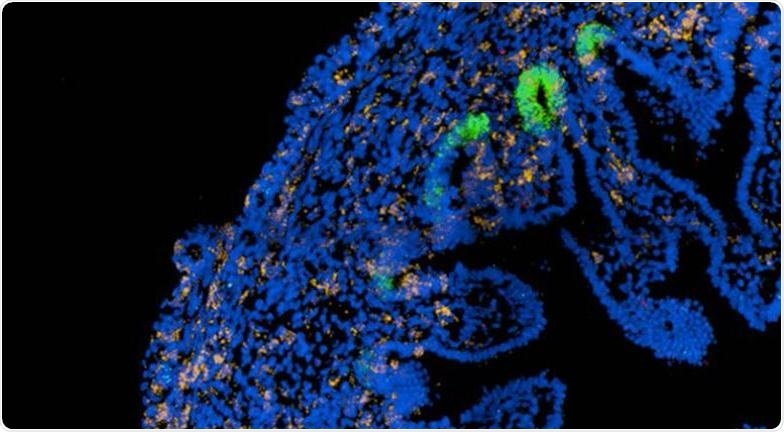Researchers have successfully monitored the initial stages of gut development in a human fetus, in explicit detail. They have also identified particular cell functions that seem to be re-stimulated in the gut of children suffering from Crohn’s Disease.

Emerging intestinal villi with stem cells (green) supporting their growth. Image Credit: Kenny Roberts and Sophie Pritchard, Wellcome Sanger Institute.
The findings represent a significant step for managing and treating this devastating disease.
Performed by the University of Cambridge and the Wellcome Sanger Institute, the study is part of the global Human Cell Atlas initiative that is aiming to plot all types of cells in the human body. The results also show the complex cellular mechanisms involved in the development of the gut.
Crohn’s Disease can be described as a form of Inflammatory Bowel Disease that affects approximately one in every 650 persons in the United Kingdom. In recent years, the incidence has increased quite considerably, particularly in children who can suffer highly aggressive symptoms like fatigue, diarrhea, and abdominal pain.
This chronic medical condition can have significant implications on lives; treatments usually do not work, the cause is not understood, and no cure is available yet.
Crohn’s Disease can be particularly aggressive and more treatment-resistant in children, so there’s a real need to understand the condition when it affects them and perhaps come up with childhood-specific treatments.”
Dr Matthias Zilbauer, Department of Paediatrics, University of Cambridge
Dr. Zilbauer is also an honorary consultant in pediatric gastroenterology at Addenbrooke’s Hospital, Cambridge University Hospitals NHS Foundation Trust, which headed the research work.
Using an advanced technology known as single-cell RNA sequencing, the investigators looked at the expression of genes in individual cells of the developing human gut, after a conception period of 6 to 10 weeks.
The team targeted the intestinal epithelium—the inner lining of the gut—and found that the cells in this region divide continuously at this early stage, directed by messages from other types of cells. This enables the gut to grow and create the structures required to ensure the excellent function of the gut later in life.
The researchers also analyzed tissues obtained from the guts of children suffering from Crohn’s Disease and aged between 4 and 12. The study showed that certain cellular pathways, which are active in the fetal gut epithelium, seem to be re-stimulated in Crohn’s Disease. Such cellular pathways were inactive in healthy children of an analogous age. The results of the study were recently published in the Developmental Cell journal.
Our results indicate there might be a reprogramming of specific gut cell functions in Crohn’s Disease. We don’t know whether this is the cause of the disease or a consequence of it, but either way it is an exciting step in helping us to better understand the condition.”
Dr Matthias Zilbauer, Department of Paediatrics, University of Cambridge
These latest findings provide a better understanding of the underlying molecular mechanisms of the development of the human gut. The researchers also observed that “mini-guts” grown in laboratory settings go through analogous individual cellular variations to those within a developing fetus.
This indicates that models grown in laboratory settings are a precise and robust tool for upcoming studies into the initial development of the gut and associated disorders.
“This study is part of the international Human Cell Atlas effort to create a ‘Google map’ of the entire human body. With single-cell RNA sequencing we can look at any tissue and identify the individual cell types it’s made up of, the function of those cells, and even identify new cell types,” stated Dr. Sarah Teichmann from the Wellcome Sanger Institute.
Dr. Teichmann is also the co-chair of the Human Cell Atlas Organising Committee, whose know-how helped analyze the massive amount of data produced by this method.
“A complex tissue like the gut contains different cell types, and these ‘talk’ to each other - the function of one cell affects the function of another. That’s particularly important in the early stages of gut development, and something we can interrogate using computational analyses of single-cell RNA sequencing data,” she added.
While the research work particularly targeted the dynamics of intestinal epithelial cells, it produced data on about 90,000 primary human intestinal cells of all types.
The team has now made this information openly available at www.gutcellatlas.org, creating a useful resource for drug discovery and additional studies focused on childhood Crohn’s Disease.
From my own experience we’re diagnosing Crohn’s Disease in younger and younger children, some even under the age of five—it’s very much an emerging disease. It’s a really nasty, lifelong condition, and when children are diagnosed, the whole family is affected.”
Dr Matthias Zilbauer, Department of Paediatrics, University of Cambridge
“We are determined to advance our knowledge in this area, and hopefully improve the lives of these children in the future.” Dr. Zilbauer concluded.
Source:
Journal reference:
Elmentaite, R., et al. (2020) Single-Cell Sequencing of Developing Human Gut Reveals Transcriptional Links to Childhood Crohn’s Disease. Developmental Cell. doi.org/10.1016/j.devcel.2020.11.010.